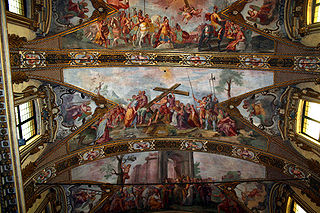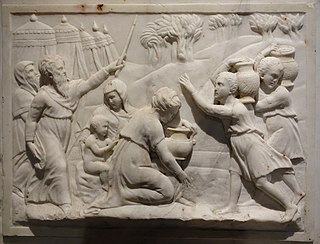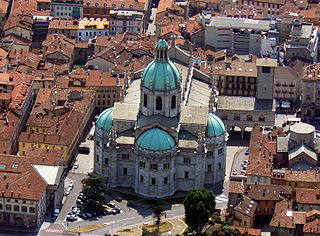History
They were bankers of the Casane astigiane first in Genoa and then in France and in Belgium. In 1337 Antonio Scarampi, in exchange for 115,000 florins, became feudatory of Bubbio, Monastero Bormida, Roccaverano, Cortemilia, Perletto, Cairo, Altare and other places of the Langhe. Oddone, Giacomo and Giovannone, three of the five sons of Antonio, each originated their own lineages. Notably, the lineages that are still present nowadays are: Scarampi del Cairo, Scarampi di Villanova and Scarampi di Pruney.

The Faà di Bruno family is the name of an Italian noble family based in the areas of Asti, Casale, and Alessandria, which provided the Counts of Bruno. In 1703 the family became additionally counts of Carentino.

Alessandro Magnasco, also known as il Lissandrino, was an Italian late-Baroque painter active mostly in Milan and Genoa. He is best known for stylized, fantastic, often phantasmagoric genre or landscape scenes. Magnasco's distinctive style is characterized by fragmented forms rendered with swift brushstrokes and darting flashes of light.

Camino is a comune (municipality) in the Province of Alessandria in the Italian region Piedmont, located about 45 kilometres (28 mi) east of Turin and about 40 kilometres (25 mi) northwest of Alessandria. As of 31 December 2004, it had a population of 763 and an area of 18.4 square kilometres (7.1 sq mi).

Cairo Montenotte is a comune (municipality) in the Province of Savona in Liguria, an Italian region located 50 kilometres (31 mi) west of Genoa and 20 kilometres (12 mi) northwest of Savona. Located in Val Bormida, it is a member of the Comunità Montana Alta Val Bormida. It is considered to be the main centre of Val Bormida and it has 12691 inhabitants. It is the fourth municipality in the province together with Savona, Albenga and Varazze, as well as the most popular municipality in Liguria among those without outlet on the sea. The municipal area is the biggest in the province behind Sassello, and the fifth in Liguria.

The Diocese of Saluzzo is a Latin diocese of the Catholic Church in the Piedmont region of northwestern Italy, centered in the comune of Saluzzo. The diocese was established on 29 October 1511 for political reasons, to transform the Marquisate of Saluzzo into an ecclesiastic territory, and was directly dependent upon the Holy See. It is now a suffragan of the Archdiocese of Turin.

The Diocese of Cuneo is a Latin diocese of the Catholic Church in Italy. It was created in 1817, from territory that previously had belonged to the Diocese of Mondovì. It is suffragan of the Archdiocese of Turin. The first bishop of Cuneo was Amedeo Bruno di Samone from 1817 to 1838.

Giovanni Battista Carlone (1603–1684) was an Italian painter of the Baroque period, active mainly in Genoa.

Marianus IV, called the Great, was the Judge (king) of Arborea, kingdom in the island of Sardinia, from 1347 to his death. He was, as his nickname indicates, the greatest sovereign of Arborea. He was a legislator and a warrior whose reign saw the commencement of massive codification of the laws of his realm and incessant warfare with the Crown of Aragon. He was also a religious man, who had connections to Catherine of Siena. He was, in short, an "wise legislator, able politician, and valiant warrior."

Giacomo Boni was an Italian painter of the late-Baroque period, active mainly in Genoa.

Taddeo Carlone was a Swiss-Italian sculptor and architect.

Anton Maria Maragliano was an Italian sculptor of the Baroque period, known primarily for his wooden statues. He was born in Genoa, where he led an important workshop.

The Diocese of Casale Monferrato is a Latin diocese of the Catholic Church in northwest Italy, a suffragan of the Archdiocese of Vercelli which forms part of the ecclesiastical region of Piedmont. The diocese, which adheres to the Roman Rite, was established on 18 April 1474 for political reasons, to transform the Marquisate of Montferrat into an ecclesiastic territory.

Giovanni Enrico Vaymer was an Italian painter of the Baroque period.

The Diocese of Mondovì is a Latin diocese of the Catholic Church in the Ecclesiastical Region of Piedmont in Italy. Its 192 parishes are divided between the Province of Savona in the (civil) region Liguria and the Province of Cuneo in the (civil) region Piedmont. The diocese is a suffragan of the Archdiocese of Turin.

The Diocese of Como is a Latin Church ecclesiastical jurisdiction or diocese of the Catholic Church in northern Italy. It was established in the Fourth Century. It is a suffragan diocese in the ecclesiastical province of the metropolitan Archdiocese of Milan. The Bishop of Como's cathedra is in the Como Cathedral.

The Roman Catholic diocese of Bobbio was an Italian bishopric which existed from 1014 until 1986. The diocese was formed from the territory of the Abbey of Bobbio.

The Diocese of Susa is a Latin diocese of the Catholic Church in Piedmont (Italy) that was established in 1772. It is a suffragan of the archdiocese of Turin. The diocese and the city of Susa lie on the main route that leads to Italy from the Mont Cenis Pass and the Col de Montgenèvre.

The Diocese of Acqui is a Latin diocese of the Catholic Church that straddles the (civil) regions of Piedmont and Liguria, in northwest Italy. The ancient Roman name of the place was Aquae Statiellae, which was sometimes confused with Aquae Sentiae (Aix-en-Provence), and Aquae Augustae (Dax), where there were also bishops. Acqui had always been subordinate to the Province of Milan, down until 1817, when Pope Pius VII assigned it to the Province of Turin. As a suffragan of the Archdiocese of Turin, it falls within the ecclesiastical region of Piedmont.

The Church of Saint Teresa of Ávila is a Baroque-style church located on Via Santa Teresa, near Piazza San Carlo in Turin, Italy.
Giovanni Stefano Maia (1672-1747) was an Italian painter of the late Baroque period, active in Genoa and Naples.



















